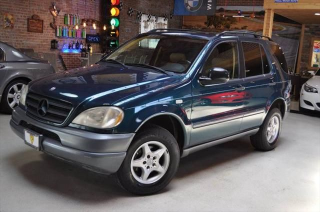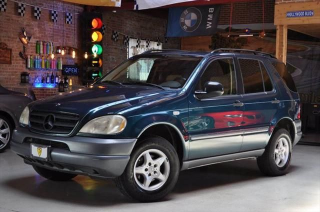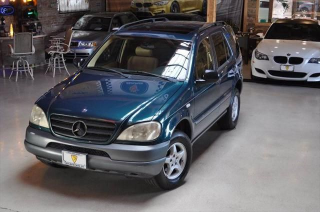The 1998 Mercedes-Benz M-Class, often referred to as the W163 generation, marked the German automaker's ambitious entry into the burgeoning luxury SUV segment. Launched in late 1997, it offered a blend of Mercedes-Benz luxury with SUV utility. Available initially in the ML320 trim, later joined by the ML430 and ML55 AMG, it catered to a premium market. Its popularity stemmed from its premium badge, comfortable ride, and the promise of German engineering in an SUV package, a relatively new concept for many consumers at the time.
The Good
The 1998 M-Class offered a refined and comfortable ride, characteristic of Mercedes-Benz. Its commanding presence and luxury interior appealed to emotional desires, while its robust construction and available V6/V8 engines provided practical capability and a sense of security for discerning buyers.
The Bad
Owners should be aware of potential electrical gremlins, particularly with the infotainment system and window regulators. Rust can be an issue on the undercarriage and wheel arches. Transmission issues and head gasket leaks are also common concerns requiring attention.
1998 Mercedes-Benz M-Class: Quick Overview
- Engine Options:
- 2.7L Inline-5 Diesel (ML270 CDI - Europe/Other Markets Only)
- 3.2L V6 (ML320)
- 4.3L V8 (ML430)
- 5.4L V8 (ML55 AMG)
- Horsepower:
- ML320: 215 hp
- ML430: 268 hp
- ML55 AMG: 342 hp
- Fuel Economy (EPA estimates, vary by year/market):
- ML320: Approximately 15 mpg city / 19 mpg highway
- ML430: Approximately 13 mpg city / 17 mpg highway
- ML55 AMG: Approximately 12 mpg city / 15 mpg highway
- 0-60 Times (approximate):
- ML320: 8.9 seconds
- ML430: 7.8 seconds
- ML55 AMG: 6.2 seconds
- Towing Capacity: Up to 5,000 lbs (properly equipped)
- Key Trim-Level Features:
- ML320: Standard features included leather upholstery, power-adjustable front seats, automatic climate control, sunroof, cruise control, premium audio system, anti-lock brakes (ABS), traction control (ASR), and airbags.
- ML430: Added a more powerful V8 engine, typically included a standard Bose sound system, and often featured upgrades to the suspension and wheels.
- ML55 AMG: Featured the AMG-tuned V8 engine, sport-tuned suspension, unique AMG body styling, larger wheels and tires, performance brakes, and exclusive interior appointments like sport seats.
1998 Mercedes-Benz M-Class Specifications
Vehicle Information
| Year | 1998 |
| Make | Mercedes-Benz |
| Model | M-Class |
| Trim | - |
| Style | - |
| Type | Wagon |
| Category | Minivan Medium Truck |
Manufacturing Details
| Made In | United States |
| Manufacturing City | - |
Dimensions
| Doors | - |
| Curb Weight | - |
| Gross Vehicle Weight Rating | - |
| Overall Height | - |
| Overall Length | - |
| Overall Width | - |
| Wheelbase Length | - |
| Standard Seating | - |
Engine & Performance
| Engine | 3.2L V6 |
| Engine Size | 3.2L |
| Engine Cylinders | 6 |
| Transmission | - |
| Transmission Type | - |
| Transmission Speeds | - |
| Drivetrain | All-Wheel Drive |
Additional Features
| Anti-Brake System | - |
| Steering Type | - |
Pricing
| Manufacturer Suggested Retail Price (MSRP) | - |
| Invoice Price | - |
| Delivery Charges | - |
Vehicle History Report
Vehicle
Specifications
Specifications
Ownership
History
History
All History
Events
Events
NMVTIS Title
History Check
History Check
Salvage/Rebuilt
Check
Check
Accident
Check
Check
Theft
Check
Check
Open Lien
Check
Check
Past Sale
Listings
Listings
Safety
Recalls
Recalls
Odometer
Check
Check
Market Price
Analysis
Analysis
What Problems Does the 1998 Mercedes-Benz M-Class Have?
The 1998 Mercedes-Benz M-Class, while offering luxury and prestige, is known to have several common issues that impact its long-term reliability. A significant concern for this model year, and indeed the early W163 generation, is the prevalence of electrical problems. These can range from malfunctioning power windows and locks to issues with the instrument cluster and the infotainment system. The mass airflow sensor is also a frequent culprit, leading to poor engine performance and check engine lights.
Regarding the powertrain, the automatic transmission can experience issues, sometimes due to a faulty transmission control module or internal wear. Leaks are another common ailment; specifically, oil leaks from the valve covers and the dreaded head gasket leaks on V6 engines are not uncommon.
The cooling system can also be a source of trouble, with radiator leaks and failing water pumps. The catalytic converter is another component that may require replacement over time.
Rust is a notable concern, particularly on the body panels, wheel arches, and the undercarriage, especially in regions exposed to road salt.
While specific recalls for the 1998 model year are less frequently cited than for later years of the W163, it is always prudent for potential buyers to check for any outstanding recalls that may have been issued.
Long-term reliability is often hampered by the complexity of the vehicle and the cost of specialized Mercedes-Benz parts and labor. While the core structure and engine can be durable with proper care, the numerous electronic components and potential for fluid leaks mean that ownership can become expensive if these issues are not addressed proactively.
Regarding the powertrain, the automatic transmission can experience issues, sometimes due to a faulty transmission control module or internal wear. Leaks are another common ailment; specifically, oil leaks from the valve covers and the dreaded head gasket leaks on V6 engines are not uncommon.
The cooling system can also be a source of trouble, with radiator leaks and failing water pumps. The catalytic converter is another component that may require replacement over time.
Rust is a notable concern, particularly on the body panels, wheel arches, and the undercarriage, especially in regions exposed to road salt.
While specific recalls for the 1998 model year are less frequently cited than for later years of the W163, it is always prudent for potential buyers to check for any outstanding recalls that may have been issued.
Long-term reliability is often hampered by the complexity of the vehicle and the cost of specialized Mercedes-Benz parts and labor. While the core structure and engine can be durable with proper care, the numerous electronic components and potential for fluid leaks mean that ownership can become expensive if these issues are not addressed proactively.
How long will the 1998 Mercedes-Benz M-Class last?
With diligent maintenance, a 1998 Mercedes-Benz M-Class can reasonably achieve 150,000 to 200,000 miles or more. However, this is contingent on consistent adherence to the manufacturer's service schedule and prompt attention to any emerging issues. Weaknesses tend to manifest in electrical systems, cooling components, and potential for rust over time, especially in harsher climates. The long-term durability is highly dependent on the owner's commitment to preventative maintenance and their willingness to invest in repairs, as specialized parts and labor can be costly. Neglected vehicles are more prone to premature failure of critical systems.
What Technology & Safety Features are Included?
The 1998 Mercedes-Benz M-Class offered a respectable suite of technology, driver-assistance, and safety features for its era, reflecting its premium positioning. Standard tech included a power-adjustable steering column, cruise control, and an automatic climate control system. The audio system was typically a premium unit, often with cassette and CD player capabilities, and some models featured a Bose sound system as standard or optional, providing a higher fidelity listening experience.
Driver-assistance features were relatively basic by today's standards but included Anti-lock Braking System (ABS) and ASR (Acceleration Slip Regulation) traction control, designed to enhance stability and control in various driving conditions.
Safety was a priority, with standard dual front airbags. Side airbags were not commonly standard on the 1998 model but became more prevalent in later years of the W163 generation. The robust body structure of a Mercedes-Benz vehicle also contributed to its safety profile.
Optional features could significantly enhance the M-Class experience. These often included leather upholstery, heated front seats, a power sunroof, and an integrated navigation system (though rudimentary by modern standards). The optional premium audio system was a popular upgrade.
Regarding crash-test ratings, specific official ratings for the 1998 model from organizations like the NHTSA or IIHS are not as readily available or standardized as they are today. However, Mercedes-Benz vehicles of this era were generally engineered to high safety standards, and the M-Class was designed with crumple zones and a reinforced passenger cell. Initial testing and reviews indicated a good level of occupant protection for its time.
Driver-assistance features were relatively basic by today's standards but included Anti-lock Braking System (ABS) and ASR (Acceleration Slip Regulation) traction control, designed to enhance stability and control in various driving conditions.
Safety was a priority, with standard dual front airbags. Side airbags were not commonly standard on the 1998 model but became more prevalent in later years of the W163 generation. The robust body structure of a Mercedes-Benz vehicle also contributed to its safety profile.
Optional features could significantly enhance the M-Class experience. These often included leather upholstery, heated front seats, a power sunroof, and an integrated navigation system (though rudimentary by modern standards). The optional premium audio system was a popular upgrade.
Regarding crash-test ratings, specific official ratings for the 1998 model from organizations like the NHTSA or IIHS are not as readily available or standardized as they are today. However, Mercedes-Benz vehicles of this era were generally engineered to high safety standards, and the M-Class was designed with crumple zones and a reinforced passenger cell. Initial testing and reviews indicated a good level of occupant protection for its time.
What Colors Options are Available?
1998 Mercedes-Benz M-Class Prices and Market Value
When new, the 1998 Mercedes-Benz M-Class represented a significant investment. The ML320 typically started in the mid-$30,000s, while the ML430 commanded prices in the high-$40,000s, and the ML55 AMG could easily exceed $60,000.
Currently, used market prices for a 1998 M-Class vary widely, often ranging from $2,000 to $7,000 depending on mileage, condition, and trim level.
The depreciation curve for the 1998 M-Class has been steep, as is common for luxury vehicles, especially those with known long-term reliability concerns. Factors affecting resale value include maintenance history (a well-documented service record is crucial), the presence of significant mechanical or electrical issues, and overall cosmetic condition. Higher mileage examples or those with visible rust or unrepaired damage will fetch considerably less.
Currently, used market prices for a 1998 M-Class vary widely, often ranging from $2,000 to $7,000 depending on mileage, condition, and trim level.
The depreciation curve for the 1998 M-Class has been steep, as is common for luxury vehicles, especially those with known long-term reliability concerns. Factors affecting resale value include maintenance history (a well-documented service record is crucial), the presence of significant mechanical or electrical issues, and overall cosmetic condition. Higher mileage examples or those with visible rust or unrepaired damage will fetch considerably less.
1998 Mercedes-Benz M-Class Cost of Ownership
Owning a 1998 Mercedes-Benz M-Class is generally considered costly. Insurance premiums can be moderate to high, reflecting its luxury status and parts cost. Fuel economy is poor, especially with the V8 engines, leading to significant fuel expenses. Maintenance, even routine, is more expensive than for mainstream SUVs due to specialized parts and labor. Repairs, particularly for electrical or transmission issues, can be very expensive. Overall, the 1998 M-Class is not an economical vehicle to own; buyers should budget for higher-than-average ownership costs.
1998 Mercedes-Benz M-Class Fuel Efficiency
Fuel Type
Gasoline
Fuel Capacity
-
City Mileage
-
Highway Mileage
-
1998 Mercedes-Benz M-Class Safety Rating
NHTSA
1998 Mercedes-Benz M-Class Insurance
Insurance for a 1998 Mercedes-Benz M-Class is moderately priced, reflecting its status as a Wagon with strong safety ratings and
reasonable repair costs.
reasonable repair costs.
How Does the 1998 Mercedes-Benz M-Class Compare to Other Wagon?
The 1998 Mercedes-Benz M-Class entered a competitive luxury SUV landscape populated by vehicles like the Lexus RX 300, BMW X5 (debuting in 1999), and the Land Rover Discovery.
Performance: The ML320's V6 offered adequate performance, but rivals like the Lexus RX 300 (with its V6) provided a smoother, more car-like driving experience. The BMW X5, when it arrived, significantly raised the bar for performance and handling in the segment. The ML430 and ML55 AMG offered stronger powertrains, with the ML55 being a performance SUV outlier.
Features: Mercedes-Benz typically led in luxury appointments and comfort features, offering upscale interiors and advanced (for the time) amenities. The Lexus RX 300 also provided a well-appointed cabin with a focus on refinement. The Land Rover Discovery offered superior off-road capability but lagged in on-road refinement and technology.
Reliability: This is where the 1998 M-Class often faltered compared to rivals. The Lexus RX 300 is renowned for its exceptional reliability and lower ownership costs. BMWs, while offering engaging performance, can also be costly to maintain. Land Rovers have their own set of reliability quirks, often related to their rugged nature.
Price: The M-Class debuted with a premium price tag, positioning it against other luxury marques. The RX 300 was often priced more competitively, offering strong value.
Recommendations: For buyers prioritizing long-term reliability and lower running costs, the Lexus RX 300 (first generation) is a significantly better alternative. If a more engaging driving experience and performance are key, and budget allows for potential maintenance, the early BMW X5 (E53 generation) is a strong contender, though it arrived a year later. For those needing serious off-road prowess, the Land Rover Discovery Series II is a more capable option, but with its own set of complex issues. The 1998 M-Class is best suited for those who appreciate the Mercedes-Benz badge and luxury but are prepared for potentially higher maintenance expenses and are buying at a significantly reduced price point.
Performance: The ML320's V6 offered adequate performance, but rivals like the Lexus RX 300 (with its V6) provided a smoother, more car-like driving experience. The BMW X5, when it arrived, significantly raised the bar for performance and handling in the segment. The ML430 and ML55 AMG offered stronger powertrains, with the ML55 being a performance SUV outlier.
Features: Mercedes-Benz typically led in luxury appointments and comfort features, offering upscale interiors and advanced (for the time) amenities. The Lexus RX 300 also provided a well-appointed cabin with a focus on refinement. The Land Rover Discovery offered superior off-road capability but lagged in on-road refinement and technology.
Reliability: This is where the 1998 M-Class often faltered compared to rivals. The Lexus RX 300 is renowned for its exceptional reliability and lower ownership costs. BMWs, while offering engaging performance, can also be costly to maintain. Land Rovers have their own set of reliability quirks, often related to their rugged nature.
Price: The M-Class debuted with a premium price tag, positioning it against other luxury marques. The RX 300 was often priced more competitively, offering strong value.
Recommendations: For buyers prioritizing long-term reliability and lower running costs, the Lexus RX 300 (first generation) is a significantly better alternative. If a more engaging driving experience and performance are key, and budget allows for potential maintenance, the early BMW X5 (E53 generation) is a strong contender, though it arrived a year later. For those needing serious off-road prowess, the Land Rover Discovery Series II is a more capable option, but with its own set of complex issues. The 1998 M-Class is best suited for those who appreciate the Mercedes-Benz badge and luxury but are prepared for potentially higher maintenance expenses and are buying at a significantly reduced price point.
Final Verdict: Is the 1998 Mercedes-Benz M-Class a Good Wagon?
The 1998 Mercedes-Benz M-Class is ideal for buyers who prioritize the prestige of the Mercedes-Benz brand and a comfortable, luxurious SUV experience, and who are on a tighter budget for their initial purchase. It is worth buying, but only under very specific conditions: as a second or third vehicle, purchased at a low price, with a thorough pre-purchase inspection by a mechanic specializing in Mercedes-Benz. It is best suited for those with mechanical aptitude or a reliable mechanic ready to address potential issues.
Given its age and known reliability concerns, buying a 1998 M-Class as a primary vehicle for daily commuting or long-distance travel is generally not recommended without substantial financial reserves for repairs. Focus on well-maintained examples, ideally with detailed service records. Avoid high-mileage vehicles unless the price reflects their condition. The ML320 is likely the most sensible choice for a balance of features and potential cost of ownership compared to the V8 variants.
Given its age and known reliability concerns, buying a 1998 M-Class as a primary vehicle for daily commuting or long-distance travel is generally not recommended without substantial financial reserves for repairs. Focus on well-maintained examples, ideally with detailed service records. Avoid high-mileage vehicles unless the price reflects their condition. The ML320 is likely the most sensible choice for a balance of features and potential cost of ownership compared to the V8 variants.


